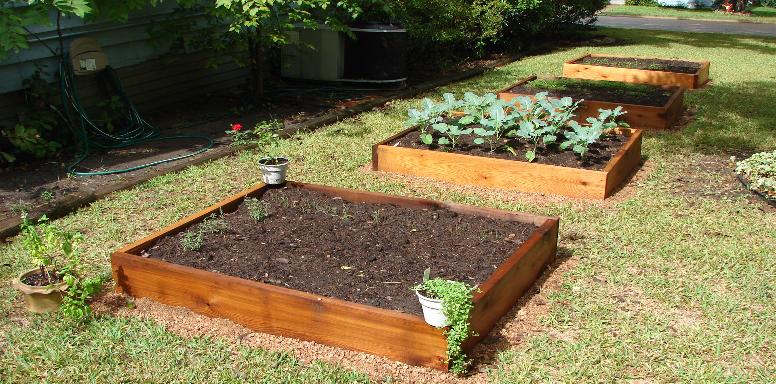(Good political news for the organically minded!)
(Farmer Brad's page)
(Spoiled goats, fresh cheese!)
What is Community Supported Agriculture (CSA)?
http://www.localharvest.org/csa/
Why make your landscaping edible?

Raised beds in a garden or farm always look beautiful. On the farm, established raised beds bestow order and pattern to what might otherwise be a blank flat space. The raised beds and sunken paths guide the farmer as he works his field, indicating where to spread compost for maximum effect, and where to plant. At the most basic level, the raised beds and their paths tell the farmer where to drive his tractor, and ensure that he never drives over soil he’ll later want to till.
In our home gardens as well, raised beds create a feeling of order and beauty. Lawns, paths and beds are clearly delineated, shapes and contours just make sense to the eye, and visitors immediately know where to walk and where not to.
As with so many things in life and in gardening, things that “look right” usually are right, but not always for obvious reasons. It seems intuitive that a raised bed is a little bit like a compost pile—a mound of earth rich in the substances of decomposition. But what is it about being raised up that gives a piece of land extra special powers? Where does the “rightness” come from?
I took all my questions to the Pfeiffer Center in Chestnut Ridge, New York, and Mac Mead’s recent workshop, “Raised Beds in the Garden and the Farm Organism.” Mac has been farming biodynamically for more than 30 years, and has helped develop methods for the practical production of vegetables in raised bed systems using both handwork and tractor-scale techniques. Last year he became director of the Pfeiffer Center. The Pfeiffer Center hosts many workshops as well as a highly regarded year-long part-time course on Biodynamics, a form of organic agriculture and land care that emphasizes working with nature’s rhythms and forces to strengthen the soil as we work it.
Mac explained that the soil surface represents a boundary between two distinct realms. Below the surface we find soil (which is a structure of solids and spaces), water, stillness and darkness; when the temperature changes in this realm, it does so slowly. Above the soil surface we find air, sunlight, warmth and movement, a realm of constant and often rapid changes: from warm to cool, from sunny to shaded, from still to wind-blown. At the soil surface is a transitional space that has some characteristics of both realms, and spanning all three of these spaces is the plant, its roots intertwined with the underground realm while its stems and leaves waft in the airy environment above.
A germinating seed draws upon the earth’s liveliness to send down a tiny root and then push up a stem and unfurl its cotyledon. If it only had the earthly forces at its disposal, the plant would never get above the ground; but the first leaves enable the plant to draw upon the liveliness and nourishment swirling in the air, sending them down into its roots, nourishing the plant and enlivening the earth. Legumes—“the lungs of the earth,” with their awe-inspiring nitrogen-fixing powers—are the ultimate example of this activity. Like their roots below ground, the plants’ above-ground vegetation traps and holds the lively forces in water, air and sun that cause plants to flourish. Have you ever wondered, for example while looking at a cornfield in August, why the plants in the center of a plot are larger and fuller than those at the edges? It’s because the ones in the center benefit from this aura-like mini-environment created and held by their own vegetation.
Another example of this phenomenon—the aura of liveliness that surrounds the plant—can be found in the crown of a tree. Anyone who has climbed a tree vividly recalls that special feeling of refined, heightened liveliness that permeates the leafy upper reaches of a tree in midsummer.
When we build up a raised bed—whether with a hoe and spade in the garden or with a tractor and disc harrow on the farm—we take some soil and elevate it above its surroundings, just as plants and trees draw the earth’s lively minerals and moisture up out of the soil, gathering the liveliness around themselves like a cloak. The act of consolidating and adding to soil to raise it above its surroundings fosters the interplay between the realm above and the realm below, creating conditions for life and growth. The simple act of raising the soil makes it more alive. Raising a bed and then putting furrows down it multiplies the effect.
Double-digging is the method of choice for making raised beds in the garden. Take care not to disrupt the community of the soil by turning spadefuls upside down, or by mixing soil from different layers, and you and your plants will enjoy the benefits of soft, springy, aerated soil that is raised by virtue of having been double-dug, and then amended with a generous layer of finished compost. The tree raises the earth up around itself as it grows, creating that special richness in its leafy crown high above the earth. When we make raised beds with spade and hoe, we bring that richness of the forest into our gardens.
This article previously appeared in the Hudson Valley Green Times, Volume 28, No. 2, Summer, 2008, and can be found here:
http://www.lilipoh.com/articles/2008issues/Winter2008/Beauty_of_Raised_Beds.aspx